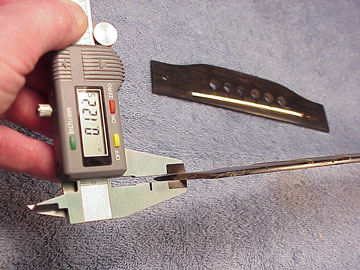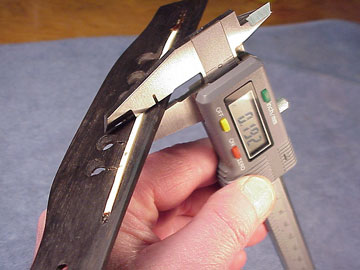Anything to Avoid Resetting That Neck
30 years ago it was commonplace to see complex repairs done in the effort to avoid resetting necks. Removing the neck seemed nearly impossible to many repairers, so they devised "workarounds" and other methods of achieving low action on guitars whose neck angle had changed. I actually heard of a violin maker who removed guitar tops and shaved the sides to achieve a taper toward the end block, and replaced the top, in effect, lowering the bridge by dropping the entire top lower in that region.
Here's a fingerboard I removed from a 1947 D-28:

I have my caliper set to the maximum thickness at the nut. You can see that the fingerboard had been planed down to less than 1/8" which is half its original thickness. At the 14th fret the fingerboard was left at full thickness, tapering back toward the peghead in a effort to avoid resetting the neck.
It must have worked for a while at least, but now look at the bridge:

It, too, has been cut drastically lower. See, it's barely over 3/16" INCLUDING the height of the saddle!
BUT, after a few more years, the action was high again, and there was neither bridge nor fingerboard left to cut lower.
After resetting the neck and replacing the fingerboard and bridge with ones of stock dimension, the guitar once again played well. The best part of the job was the "test drive" because the sound was utterly transformed. With the bridge height restored, the trebles and midrange came out dramatically stronger. This guitar went from 98-lb. weakling to Superman in one week!
